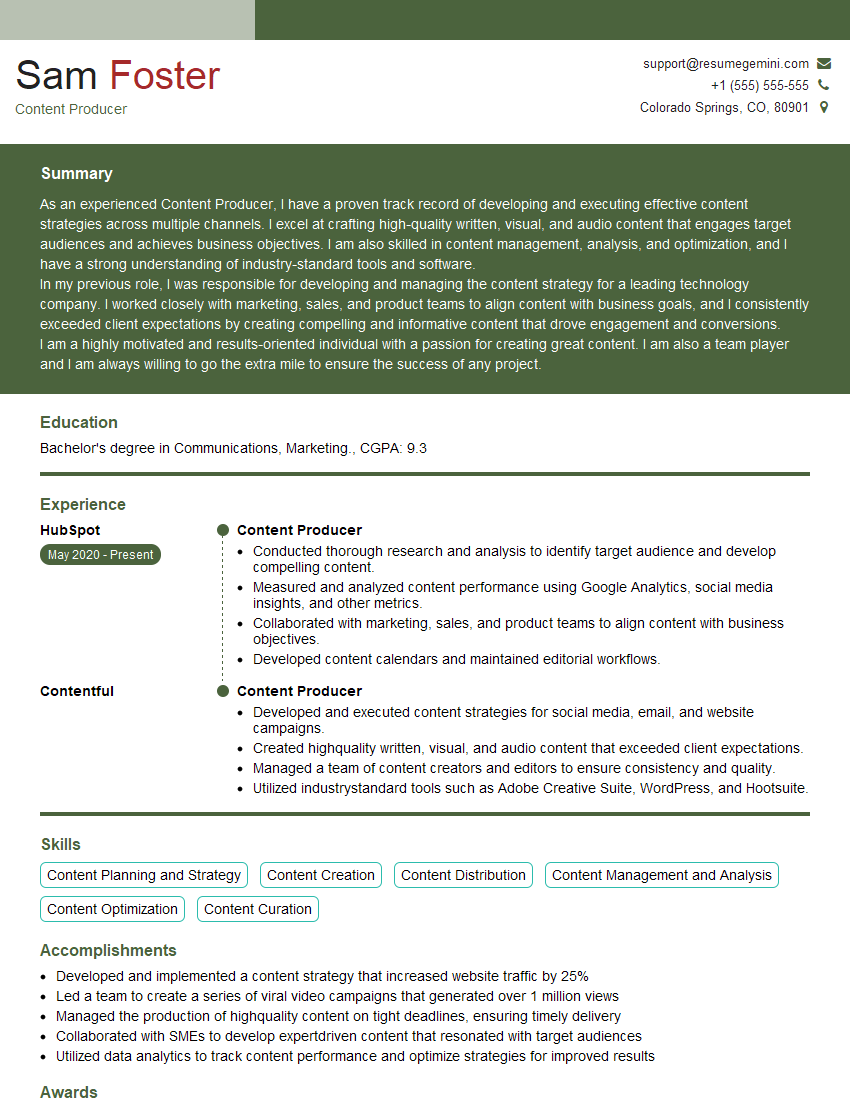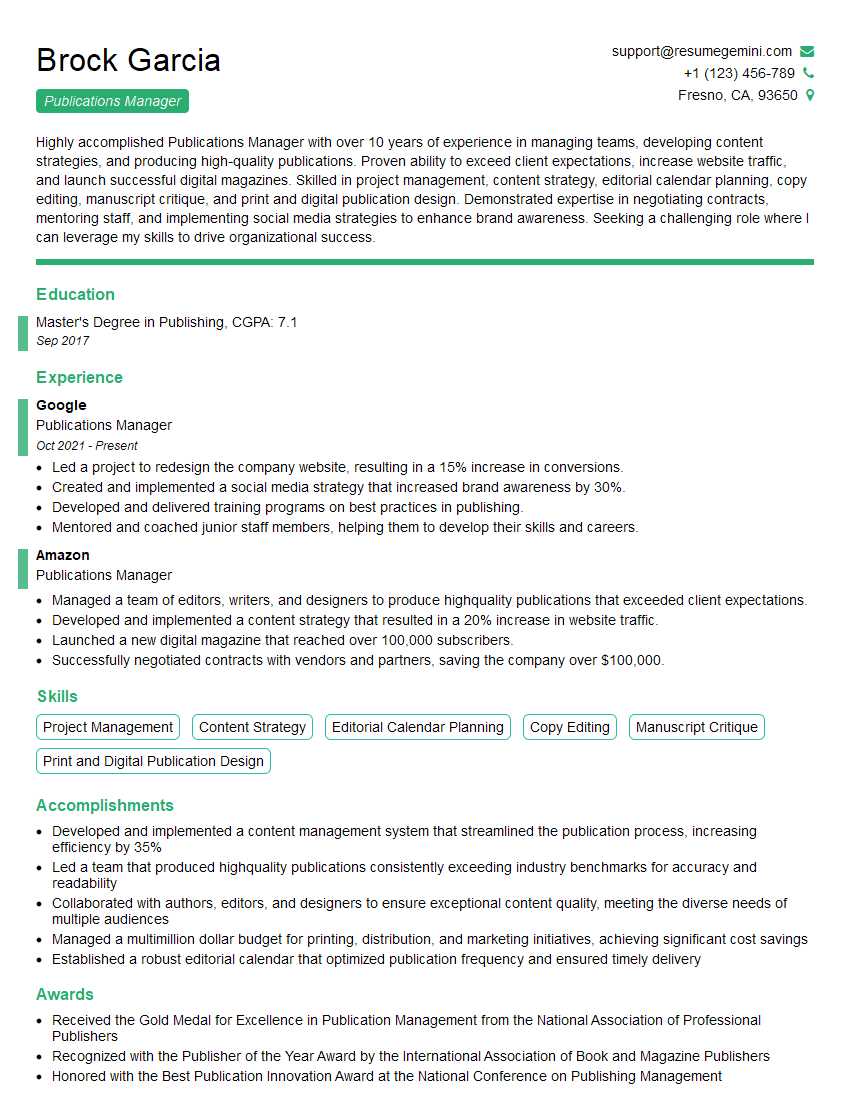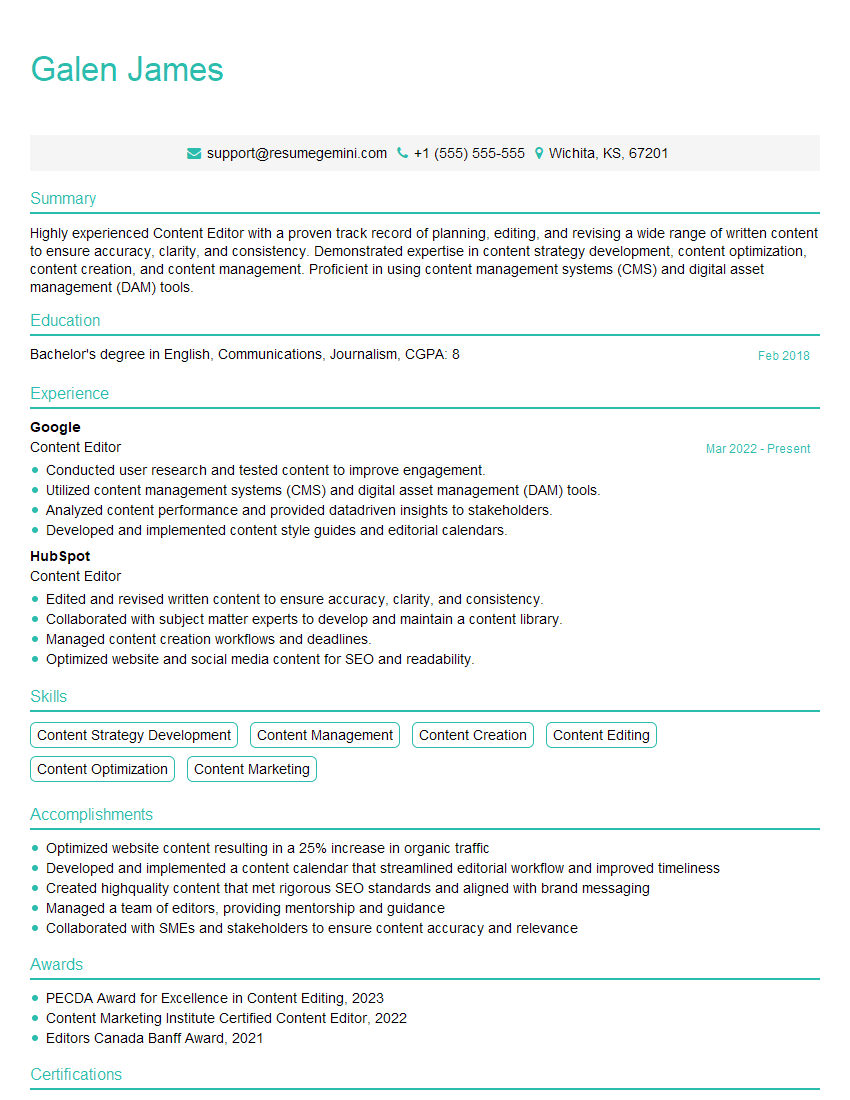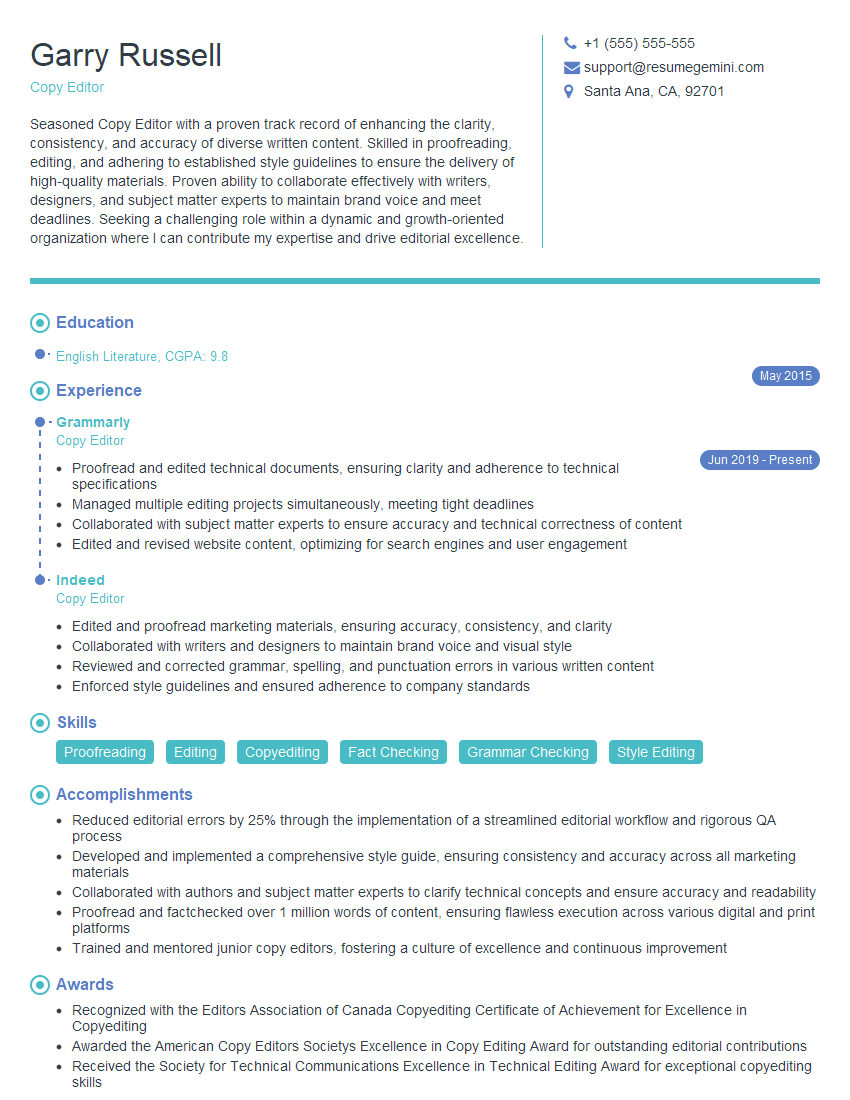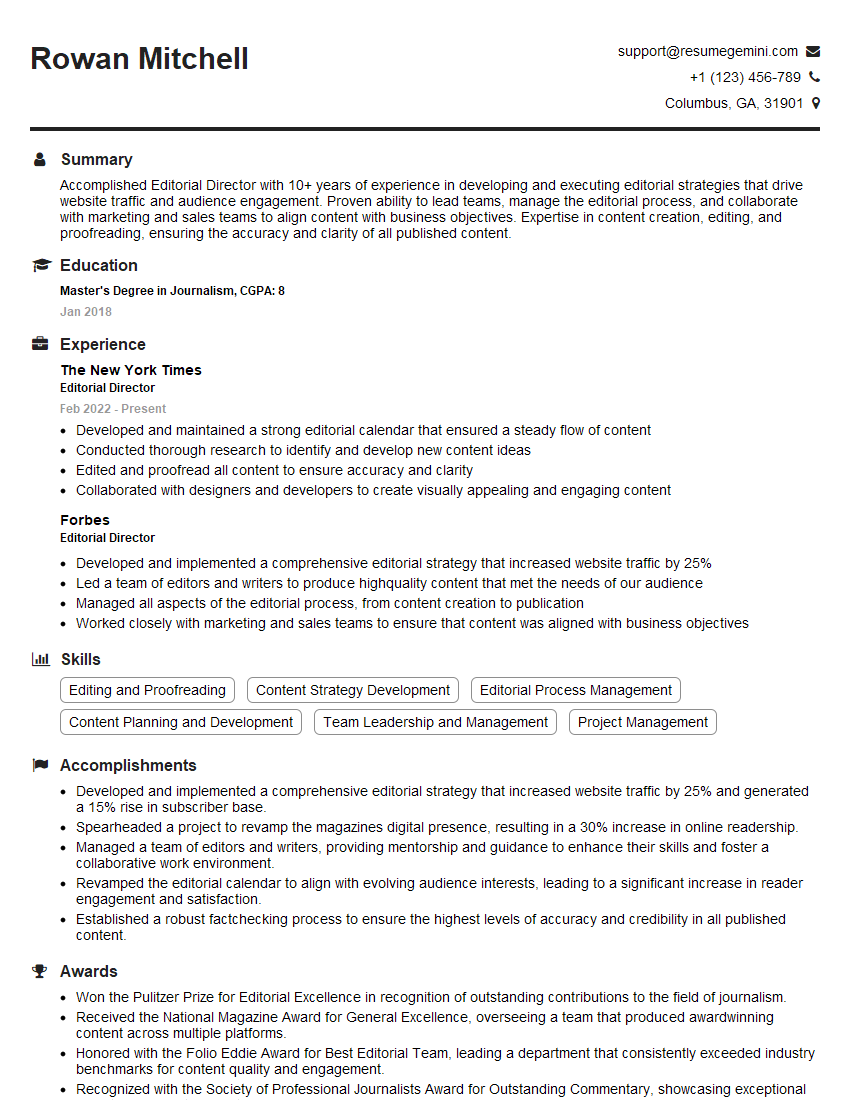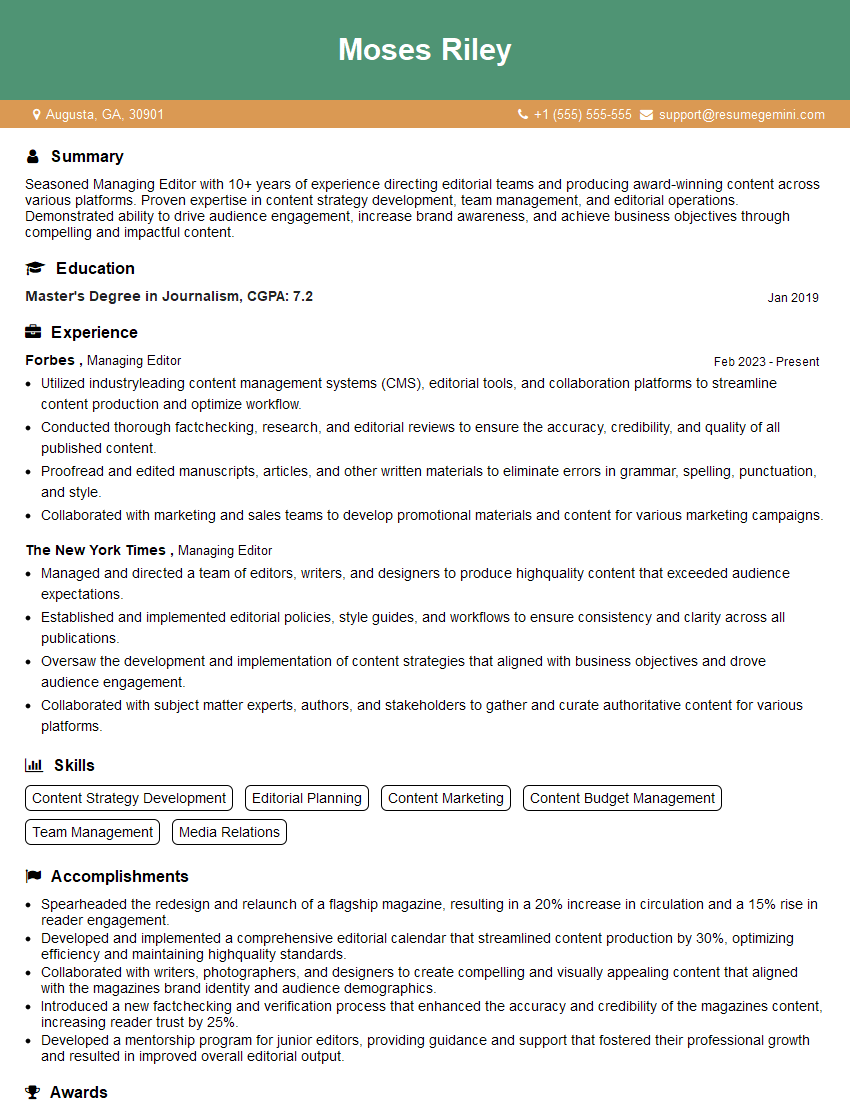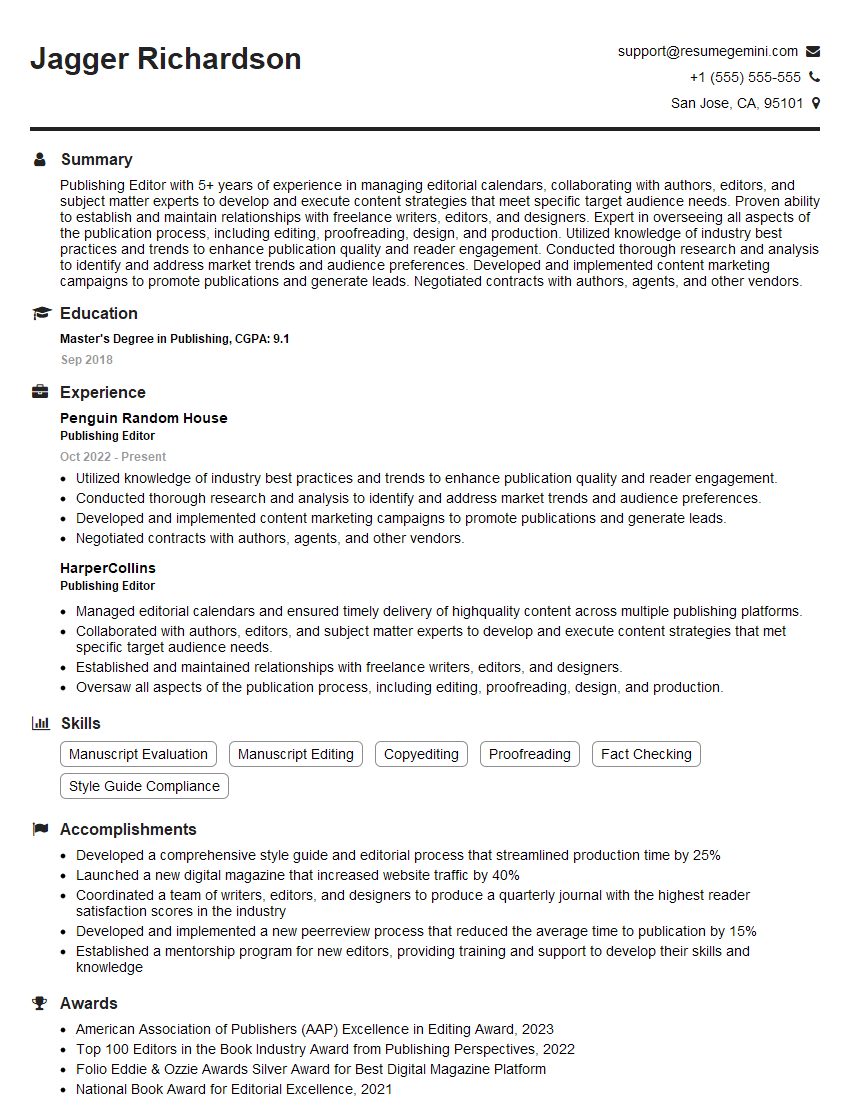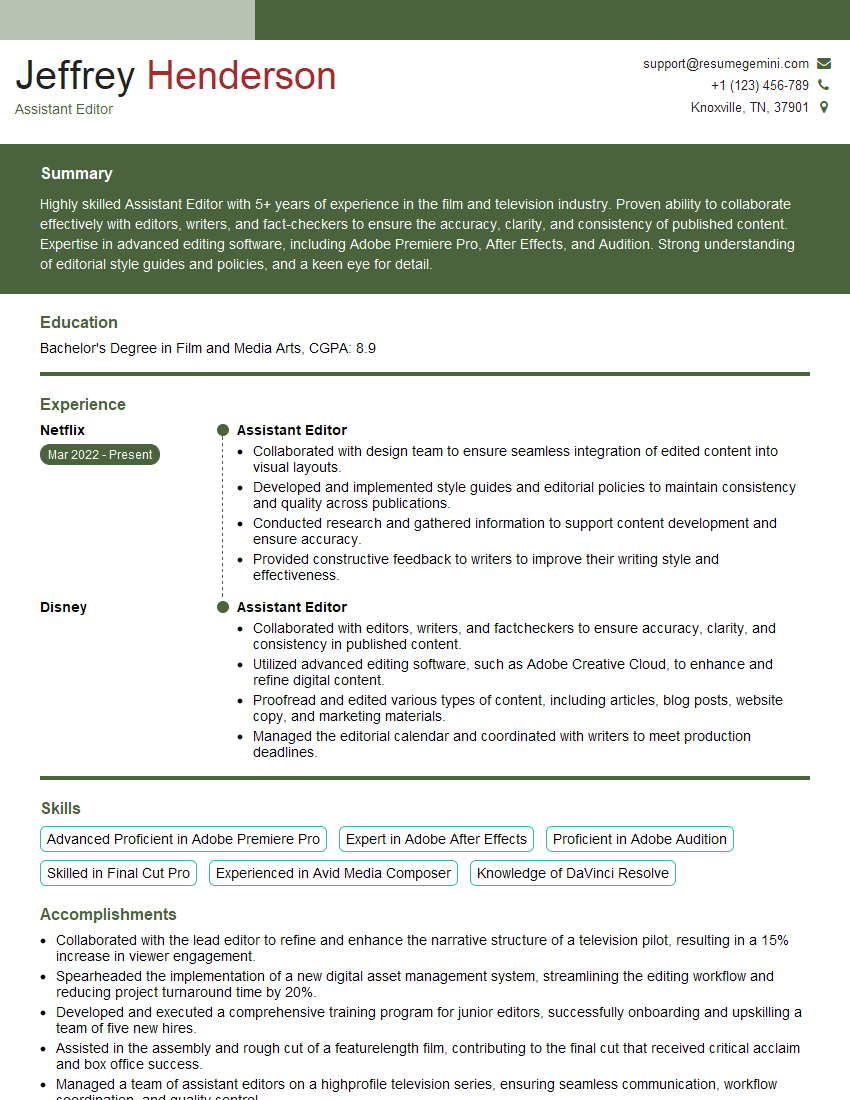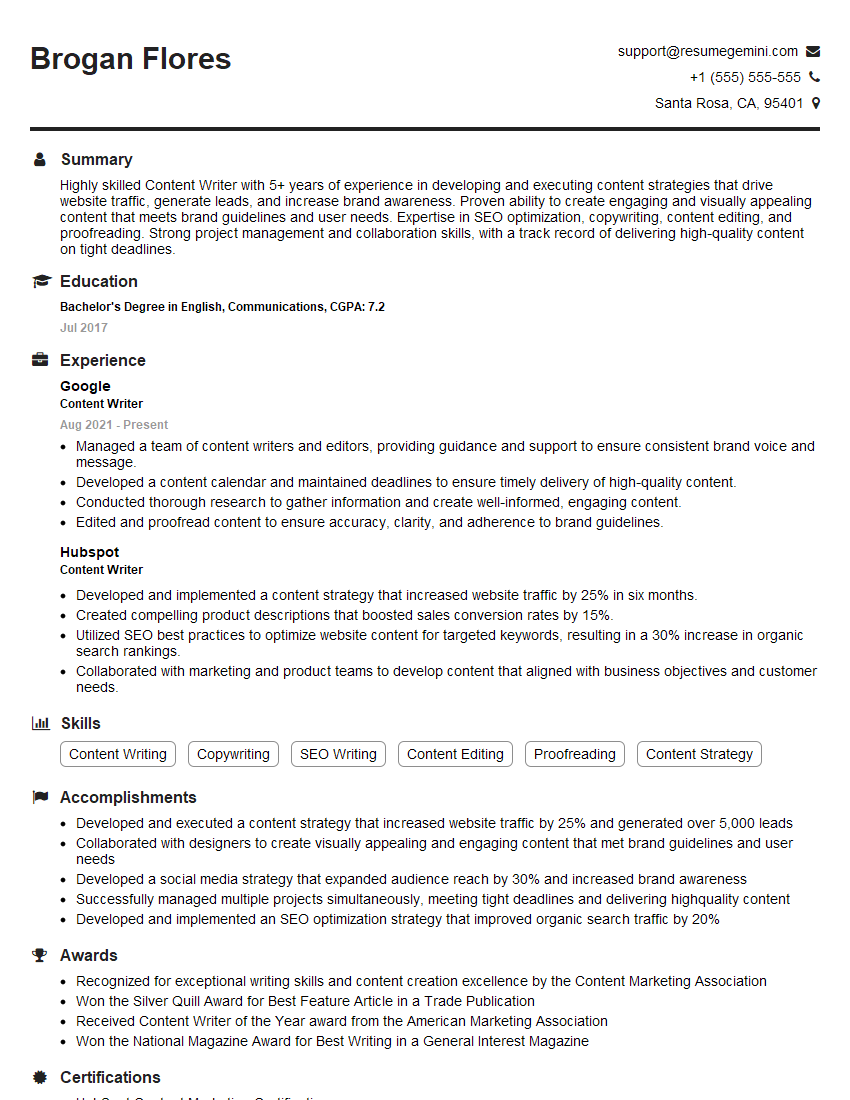Preparation is the key to success in any interview. In this post, we’ll explore crucial Editorial Planning interview questions and equip you with strategies to craft impactful answers. Whether you’re a beginner or a pro, these tips will elevate your preparation.
Questions Asked in Editorial Planning Interview
Q 1. Describe your experience creating and managing editorial calendars.
Creating and managing editorial calendars is the backbone of any successful content strategy. It’s essentially a roadmap outlining all planned content, ensuring consistent publishing and alignment with business goals. My experience involves using various tools, from simple spreadsheets to sophisticated content management systems (CMS) like WordPress, to plan and track content. I typically start by identifying key themes and topics based on audience research, keyword analysis, and business objectives. Then, I map out content formats (blog posts, videos, infographics, etc.) and assign deadlines, considering resource availability and seasonal relevance. For example, for a client in the e-commerce space, I created a calendar that heavily featured holiday-themed content leading up to major shopping seasons, optimizing for peak sales periods. The calendar wasn’t just a list of topics; it included specific goals for each piece of content, target audience, and planned distribution channels. Regular review and updates are crucial, allowing for flexibility and adaptation to changing circumstances and performance data.
In one instance, I managed the editorial calendar for a tech startup. We transitioned from a basic spreadsheet to a project management tool (Asana) to enhance collaboration and tracking capabilities. This allowed for smoother workflow, more effective delegation, and better progress monitoring.
Q 2. How do you prioritize competing editorial deadlines?
Prioritizing competing deadlines requires a systematic approach. I employ a combination of methods, including the MoSCoW method (Must have, Should have, Could have, Won’t have) to categorize tasks based on their urgency and importance. This helps to visualize the critical path and ensure the most impactful content gets published on time. I also use a project management matrix, plotting deadlines against resources and dependencies to identify potential conflicts early on. This allows me to proactively address challenges, re-allocate resources, or adjust deadlines where necessary. For example, if a high-priority blog post requires extensive research and interviews, I would prioritize it over a less critical piece of content with a similar deadline, adjusting the latter’s schedule if needed.
Transparency is also key. Regular team meetings to discuss progress, roadblocks, and potential adjustments ensures everyone is aligned and aware of the priorities. This proactive communication mitigates the risk of missed deadlines and prevents conflicts from escalating.
Q 3. Explain your process for assigning content to writers or editors.
Assigning content involves understanding both the writer’s expertise and the content’s requirements. I consider each writer’s strengths, experience, and writing style when making assignments. I also take into account the complexity of the topic, the target audience, and the desired tone. For example, a writer with a strong background in finance would be ideal for a complex article on investment strategies, while a writer with a more conversational style would be better suited for creating engaging social media content. I usually have a style guide and a brief outlining the specific requirements for each piece of content, ensuring consistency in quality and voice across all publications. I may use a content assignment spreadsheet or a project management tool to keep track of assignments and deadlines, ensuring accountability and transparency.
I also emphasize regular communication with writers, providing feedback and guidance throughout the writing process. A well-defined workflow, clear communication and frequent check-ins contribute to better content and on-time delivery.
Q 4. How do you ensure editorial content aligns with overall business objectives?
Ensuring editorial content aligns with business objectives is paramount. Before developing the editorial calendar, I work closely with the business team to understand key goals, marketing strategies, and target audience. I translate these business objectives into specific, measurable content goals. For instance, if the business aims to increase brand awareness, the editorial calendar will feature content designed to reach a wider audience and enhance brand visibility. If the goal is lead generation, the calendar will prioritize content that drives traffic to landing pages and encourages conversions. I use tools like Google Analytics and other relevant platforms to track the performance of the content and make data-driven decisions about future content creation.
I also regularly review the editorial calendar with the business team to ensure the content remains aligned with evolving business priorities and market trends. This collaborative approach fosters a shared understanding and accountability, ensuring that editorial efforts directly support business growth.
Q 5. What metrics do you use to measure the success of editorial initiatives?
Measuring the success of editorial initiatives requires a multifaceted approach. I typically use a combination of quantitative and qualitative metrics. Quantitative metrics include website traffic (unique visitors, page views, bounce rate), social media engagement (likes, shares, comments), lead generation (form submissions, email sign-ups), and conversion rates. Qualitative metrics include brand sentiment analysis (monitoring social media conversations and online reviews), audience feedback surveys, and content performance reports. For example, a high bounce rate might indicate that the content is not engaging enough, while a low conversion rate may suggest issues with the call to action.
By tracking these metrics, I can identify what’s working, what’s not, and adjust the editorial strategy accordingly. Regular reporting and analysis provide valuable insights for optimizing content performance and achieving business objectives. I utilize tools like Google Analytics, social media analytics dashboards, and CRM systems to gather and analyze this data.
Q 6. Describe your experience with content repurposing and syndication.
Content repurposing and syndication are effective strategies for maximizing the reach and impact of editorial content. My experience includes transforming long-form blog posts into shorter social media updates, creating infographics from data-driven articles, and adapting video scripts into podcasts. I also actively explore syndication opportunities, partnering with relevant websites and publications to distribute content to a wider audience. This not only increases visibility but also strengthens SEO (Search Engine Optimization) and builds backlinks to the primary website. For example, I successfully repurposed a detailed blog post about sustainable living into several Instagram carousel posts, significantly expanding its reach and engagement.
I also make sure to carefully track the performance of repurposed and syndicated content, identifying which formats and channels are most effective. This data-driven approach helps optimize future repurposing and syndication strategies, ensuring maximum return on investment.
Q 7. How do you handle conflicting viewpoints among editorial team members?
Handling conflicting viewpoints among team members requires strong communication and mediation skills. I foster an environment of open discussion and respectful debate, encouraging everyone to express their ideas and perspectives. The goal isn’t to avoid conflict, but to manage it constructively. I use a collaborative approach, encouraging brainstorming sessions and using data and research to inform decisions. When disagreements persist, I facilitate a structured discussion, ensuring everyone feels heard and understood. I then guide the team toward a consensus or compromise that aligns with the overall editorial strategy and business objectives. For example, if two editors have differing opinions on the tone of a particular article, I would encourage them to present their arguments supported by data and examples, ultimately guiding them towards a tone that resonates with the target audience.
Ultimately, the success of managing diverse perspectives comes down to active listening, respectful dialogue and a focus on achieving a common goal. A collaborative and supportive environment encourages creative thinking and avoids unnecessary friction.
Q 8. How familiar are you with content management systems (CMS)?
I’m highly proficient with various Content Management Systems (CMS), including WordPress, Drupal, and Contentful. My experience encompasses not only using these platforms for content creation and publishing but also managing their configurations, user permissions, and workflows. I understand the importance of choosing the right CMS based on project needs and scalability. For example, WordPress is excellent for smaller blogs and websites, while Drupal offers more complex functionalities for larger organizations. Contentful shines when you need a headless CMS for maximum flexibility. My understanding extends to utilizing plugins and extensions to enhance CMS functionalities and integrate them with other marketing tools.
In a recent project, we migrated a client’s website from a legacy system to WordPress. This involved carefully planning the migration strategy, transferring data, ensuring SEO continuity, and training the client’s team on the new CMS. The successful transition resulted in improved site performance and streamlined content management.
Q 9. How do you stay up-to-date on industry trends and best practices?
Staying current in editorial planning requires a multi-faceted approach. I regularly subscribe to industry publications like Content Marketing Institute and Copyblogger, attend webinars and conferences such as those hosted by SEMrush and Moz, and actively participate in online communities and forums related to content strategy and digital publishing. I also follow influential figures and companies in the industry on social media platforms like Twitter and LinkedIn. This allows me to access diverse perspectives, emerging trends, and best practices in real-time.
Furthermore, I dedicate time to analyzing successful content strategies from competitors and industry leaders to identify effective tactics and methodologies. This reverse-engineering process helps me adapt best practices to suit different contexts and objectives. For instance, by studying how successful publications utilize interactive content, I’ve integrated quizzes and polls into editorial calendars, leading to improved reader engagement.
Q 10. Describe your experience working with freelance writers or editors.
I have extensive experience collaborating with freelance writers and editors, having managed teams of up to ten individuals simultaneously on several large-scale projects. My approach centers around clear communication, well-defined briefs, and efficient feedback mechanisms. I always provide writers with comprehensive style guides, ensuring consistency and alignment with the publication’s voice and brand. I utilize project management tools like Asana or Trello to streamline workflow, track deadlines, and facilitate communication.
For example, when managing a team for a large-scale content series, I established a system where each writer submitted drafts to a designated editor for review before it came to me. This ensured multiple layers of quality control while also empowering the freelance editors. This tiered approach not only guaranteed high-quality content but also allowed for efficient time management and a manageable workload for both the team and myself.
Q 11. How do you ensure editorial consistency across different platforms?
Maintaining editorial consistency across platforms requires a well-defined style guide and a robust content management process. The style guide should encompass writing style, tone, voice, formatting, and brand guidelines, ensuring consistent messaging regardless of the platform. This consistency is crucial for building brand recognition and trust. In practice, this means using a single source of truth – a central repository for style guidelines – which is easily accessible to everyone involved in content creation.
I utilize templates for different content types (blog posts, social media updates, email newsletters, etc.) to ensure uniformity. I also implement a rigorous content review process before publishing, involving multiple stakeholders to check for inconsistencies. For instance, I often utilize checklists to ensure all content adheres to our established style guide before it’s shared across social media and other platforms.
Q 12. How do you manage feedback from stakeholders and incorporate it into the editorial process?
Managing stakeholder feedback effectively is crucial for successful editorial planning. I establish clear communication channels and regularly solicit feedback at various stages of the process. This involves actively seeking input during brainstorming, content development, and pre-publication review. I use collaborative tools like Google Docs or shared project management software to streamline the feedback process and ensure transparency.
To ensure feedback is incorporated efficiently, I prioritize feedback based on its relevance and impact. I maintain a detailed record of all feedback received, along with my response and rationale. For example, I might create a matrix to categorize feedback by source, type, and urgency, which helps in prioritization and decision-making. Any changes are documented, ensuring transparency and providing a clear audit trail of the editorial process.
Q 13. What is your approach to brainstorming and developing content ideas?
My approach to brainstorming and developing content ideas is data-driven and audience-centric. It typically begins with analyzing audience needs, preferences, and pain points through data analysis, using tools like Google Analytics and social media listening. I also perform thorough keyword research to understand what topics are relevant and trending within the target audience.
Brainstorming sessions often involve a combination of individual ideation and collaborative group discussions. I utilize techniques like SWOT analysis, mind mapping, and reverse brainstorming to stimulate creativity and explore diverse perspectives. Once ideas are generated, we prioritize them based on factors such as potential impact, audience engagement, and resource availability. This process often results in a well-structured content calendar with a mix of evergreen and timely content, designed to meet specific marketing objectives.
Q 14. Describe your experience with SEO optimization for editorial content.
SEO optimization is integral to my editorial planning process. I ensure that SEO considerations are incorporated from the initial stages of content creation, not as an afterthought. This involves conducting thorough keyword research to identify relevant search terms that align with the content’s topic and target audience. This isn’t just about stuffing keywords; it’s about understanding user search intent and creating high-quality, relevant content that satisfies those needs.
My approach includes optimizing on-page elements such as title tags, meta descriptions, header tags, and image alt text. I also focus on building high-quality backlinks from reputable websites, which enhances the content’s authority and search engine ranking. I regularly monitor the content’s performance using tools like Google Search Console and SEMrush to identify areas for improvement and adapt the SEO strategy as needed. For instance, if a particular keyword isn’t performing well, we might adjust the content or target a different keyword phrase.
Q 15. How do you measure the engagement of your editorial content?
Measuring editorial content engagement goes beyond simply counting views. It’s about understanding how your audience interacts with your content and whether it achieves its intended purpose. We utilize a multi-faceted approach.
- Website Analytics: We rely heavily on tools like Google Analytics to track key metrics such as page views, time on page, bounce rate, and unique visitors. A low bounce rate and high time on page suggest strong engagement. We also analyze referral sources to understand where our audience is coming from.
- Social Media Metrics: We track likes, shares, comments, and retweets on platforms like Twitter, Facebook, and LinkedIn. High engagement on social media indicates that the content is resonating with the target audience and is being shared organically.
- Conversion Rates: For content with a clear call to action (e.g., subscribing to a newsletter, downloading a resource), we monitor conversion rates to assess effectiveness. A high conversion rate signifies successful engagement and content efficacy.
- User Feedback: Direct feedback through comments, surveys, and email interactions provides valuable qualitative data. Analyzing feedback helps us identify areas for improvement and understand audience preferences.
For example, if an article about sustainable living receives numerous shares on eco-conscious social media groups and a significant increase in newsletter subscriptions, we know the content is highly engaging and successful.
Career Expert Tips:
- Ace those interviews! Prepare effectively by reviewing the Top 50 Most Common Interview Questions on ResumeGemini.
- Navigate your job search with confidence! Explore a wide range of Career Tips on ResumeGemini. Learn about common challenges and recommendations to overcome them.
- Craft the perfect resume! Master the Art of Resume Writing with ResumeGemini’s guide. Showcase your unique qualifications and achievements effectively.
- Don’t miss out on holiday savings! Build your dream resume with ResumeGemini’s ATS optimized templates.
Q 16. How do you handle unexpected delays or changes in editorial plans?
Unexpected delays or changes are inevitable in editorial planning. Our process emphasizes flexibility and proactive communication.
- Contingency Planning: We build buffer time into our editorial calendar to accommodate unforeseen circumstances. This allows for some flexibility without jeopardizing deadlines.
- Agile Approach: We embrace an agile methodology, allowing us to adapt quickly to changing priorities. This involves regular project review meetings where we assess progress and adjust plans accordingly.
- Proactive Communication: Open communication is key. If a delay or change occurs, we immediately inform all stakeholders—writers, editors, marketing, and sales—to minimize disruption and ensure everyone is on the same page.
- Prioritization: When faced with competing priorities, we use a prioritization matrix to objectively assess the importance and urgency of different editorial tasks. This allows us to make informed decisions about which content to adjust or postpone.
For instance, if a key interviewee becomes unavailable, we might quickly identify and interview an alternative expert, potentially adjusting the publication date or angle of the article.
Q 17. Describe your experience with budget management for editorial projects.
Budget management is crucial for editorial success. My experience involves meticulous planning, tracking, and analysis.
- Detailed Budgeting: We create detailed budgets outlining costs associated with each editorial project, including writer fees, editing costs, design expenses, and marketing/promotion.
- Regular Tracking: We track expenses diligently throughout the project lifecycle using spreadsheets or dedicated project management software. This allows for early identification of potential budget overruns.
- Value-Based Decisions: We make budget decisions based on the value each project brings. High-impact pieces that align with our strategic goals may justify higher budgets.
- Cost Optimization: We explore strategies to optimize costs without compromising quality, such as negotiating writer rates, using in-house resources efficiently, and leveraging free or low-cost promotional channels.
For example, if we identify a budget overrun, we may explore options like reducing the scope of a project or finding alternative, cost-effective solutions, such as leveraging existing content or repurposing it.
Q 18. How do you ensure the accuracy and quality of published content?
Ensuring accuracy and quality is paramount. We employ a multi-layered approach involving fact-checking, editing, and proofreading.
- Fact-Checking Protocols: We establish clear fact-checking protocols, requiring writers to cite credible sources and verify information. This includes independent verification by editors.
- Multiple Editing Stages: We use a multi-stage editing process involving developmental editing, copyediting, and proofreading. Each stage focuses on different aspects of quality, from overall structure and clarity to grammar and style.
- Style Guides: We adhere to consistent style guides to ensure uniformity and professionalism. This includes guidelines for grammar, punctuation, capitalization, and terminology.
- Quality Assurance Checks: Before publication, we conduct final quality assurance checks to identify any remaining errors or inconsistencies. This might involve using automated grammar checkers or having a second pair of eyes review the final draft.
For instance, if an article contains a statistic, we would cross-reference it with multiple sources to guarantee its accuracy. Any discrepancies or inconsistencies would be resolved before publication.
Q 19. How do you collaborate with other departments, such as marketing or sales?
Collaboration with other departments is crucial for successful editorial projects. We strive for seamless integration.
- Cross-Functional Meetings: Regular meetings with marketing and sales teams help align editorial content with broader business objectives. This ensures our content supports their initiatives.
- Content Briefings: We provide detailed content briefs to marketing and sales, outlining the content strategy, target audience, and key messages. This allows them to effectively promote and distribute the content.
- Feedback Loops: We establish clear feedback loops to gather insights from marketing and sales on content performance. This information helps us refine our editorial strategy and improve content effectiveness.
- Shared Goals: We work to align editorial goals with the overall marketing and sales strategies to create synergistic efforts.
For example, if the sales team is launching a new product, we will coordinate editorial content, such as blog posts, case studies, and webinars, to support the product launch and generate leads.
Q 20. What software or tools do you use for editorial planning and management?
We leverage a combination of software and tools for efficient editorial planning and management.
- Editorial Calendar Software: We use a centralized editorial calendar, such as Trello or Asana, to track editorial projects, deadlines, and assignments. This enhances transparency and accountability.
- Content Management Systems (CMS): Our content is published and managed through a CMS such as WordPress, which allows for efficient content creation, editing, and publication workflows.
- Project Management Software: We utilize project management software, such as Monday.com or Asana, to manage the entire project workflow, from initial planning to final publication, including assigning tasks, tracking progress, and monitoring deadlines.
- Collaboration Tools: Google Workspace, including Docs, Sheets, and Slides, facilitates seamless collaboration among writers, editors, and other stakeholders. This ensures smooth communication and efficient workflow.
These tools enable us to track progress efficiently, share updates with stakeholders, and manage the entire editorial process seamlessly.
Q 21. Describe a time you had to make a difficult decision regarding editorial content.
One challenging decision involved an article that contained potentially controversial viewpoints. The author presented a well-researched and compelling argument, but the opinions expressed might alienate a segment of our audience.
After careful consideration, including discussions with the editorial team, legal counsel, and relevant stakeholders, we decided to publish the article, but with significant context. We added an editor’s note clarifying the purpose of the article, emphasizing it was one perspective among many, and acknowledging the potential for diverse opinions. We also incorporated counterpoints and links to other resources representing alternative views.
While it was a risk, the decision was based on our commitment to presenting diverse perspectives within an ethical framework. The outcome was positive; it fostered a healthy discussion among readers and enhanced our reputation for thought-provoking content. The key was careful contextualization and a commitment to transparency.
Q 22. How do you handle negative feedback or criticism of published content?
Handling negative feedback is crucial for editorial growth. It’s not about ignoring criticism, but about using it constructively. My approach involves a three-step process:
- Acknowledgement and Understanding: I carefully read each piece of feedback, trying to understand the perspective of the critic. Is it a factual error? A matter of style? Or a difference in opinion? For example, if someone points out a factual inaccuracy, I prioritize correcting it immediately and publicly acknowledging the error. If it’s a matter of style, I consider whether the feedback aligns with our editorial style guide and overall tone.
- Internal Review and Discussion: I discuss the feedback with my team, weighing the validity of the points raised. This collaborative approach helps us gauge the overall impact of the criticism and determine the best course of action. Perhaps a small change is sufficient, or perhaps a more significant revision is warranted.
- Response and Improvement: Based on the internal review, I either make the necessary changes and publicly acknowledge the feedback (if appropriate), or I write a thoughtful and respectful response explaining why the changes are not being made. The goal is always transparency and improvement. Sometimes, a simple “Thank you for your feedback!” can go a long way.
Ultimately, I view negative feedback as an opportunity for learning and improvement, helping us refine our editorial process and create higher-quality content.
Q 23. How do you measure the ROI of your editorial efforts?
Measuring the ROI of editorial efforts requires a multi-faceted approach. It’s not just about clicks and shares; it’s about aligning content with business goals and tracking its contribution to those goals. Here’s how I approach it:
- Define Clear Objectives: Before creating any content, I work with stakeholders to define specific, measurable, achievable, relevant, and time-bound (SMART) goals. For example, increasing brand awareness by 20% in Q4 or generating 500 qualified leads through blog content.
- Key Performance Indicators (KPIs): I select relevant KPIs based on those objectives. These could include website traffic, social media engagement, lead generation, conversion rates, email sign-ups, and customer satisfaction scores. The choice of KPIs depends entirely on the overall goals. For instance, if the goal is brand awareness, social shares and reach are key; if it’s lead generation, form submissions and email sign-ups are crucial.
- Analytics and Reporting: I use analytics tools like Google Analytics, social media analytics dashboards, and CRM data to track the performance of our editorial content against the defined KPIs. This allows for ongoing monitoring and adjustment of our strategy.
- Attribution Modeling: I attempt to accurately attribute conversions and revenue to specific content pieces. This is often challenging but crucial for demonstrating the true ROI. Methods include last-click attribution, multi-touch attribution, and more sophisticated models.
By tracking these metrics and regularly reporting on our progress, I can demonstrate the value of our editorial efforts and inform future content strategies.
Q 24. What is your experience with different content formats (e.g., blog posts, videos, infographics)?
I have extensive experience working with diverse content formats, understanding their strengths and weaknesses in different contexts.
- Blog Posts: Ideal for in-depth explanations, thought leadership, and driving organic search traffic. I’m adept at crafting compelling narratives, optimizing for SEO, and incorporating visual elements to enhance readability.
- Videos: Excellent for demonstrating products or services, engaging audiences with storytelling, and boosting brand personality. My experience includes scripting, video production oversight, and post-production editing.
- Infographics: Highly effective for summarizing complex information visually and boosting social media engagement. I collaborate with designers to create visually appealing and informative pieces that convey data effectively.
- Podcasts: Ideal for reaching niche audiences and building community. I have experience with guest booking, interview prep, audio editing, and podcast promotion.
- Social Media Content: I have a strong understanding of how to tailor content to various platforms (e.g., Twitter, LinkedIn, Instagram, TikTok), creating engaging, short-form content relevant to each platform’s unique audience.
My selection of a particular format always depends on the audience, the message, and the desired outcome. I wouldn’t use a long-form blog post to promote a quick product update, for instance; a short, impactful video or social media post would be far more effective.
Q 25. How familiar are you with editorial style guides and best practices?
I’m intimately familiar with various editorial style guides and best practices. My experience includes working with the Associated Press (AP) style guide, Chicago Manual of Style, and various company-specific style guides. I understand the importance of consistency in:
- Grammar and Punctuation: Ensuring correct usage to maintain clarity and professionalism.
- Spelling and Terminology: Maintaining consistent spelling and using precise language to avoid ambiguity.
- Formatting and Citation: Adhering to standardized formatting guidelines and correctly citing sources to avoid plagiarism.
- Tone and Voice: Maintaining a consistent tone and voice that reflects the brand’s identity and target audience.
- Accessibility: Following guidelines to ensure content is accessible to users with disabilities, including proper use of headings, alt text, captions, etc.
I can quickly adapt to new style guides and incorporate them into my workflow seamlessly. Consistency in style is key to establishing credibility and professionalism, and I consider it a fundamental aspect of my editorial work.
Q 26. Describe your approach to identifying and addressing editorial gaps or inconsistencies.
Identifying and addressing editorial gaps or inconsistencies is an ongoing process. My approach involves:
- Regular Content Audits: I conduct regular audits of published content to identify gaps in topics, inconsistencies in style, and outdated information. This might involve using tools to analyze content performance or manually reviewing a sample of articles.
- Keyword Research and Analysis: By analyzing search data and competitor content, I identify opportunities to fill gaps in our coverage and address areas where our content is lacking.
- Audience Feedback Analysis: I actively monitor audience feedback, including comments, social media mentions, and customer surveys, to pinpoint areas where our content is failing to meet their needs or expectations.
- Content Calendar Review: I review our content calendar regularly to identify potential overlaps, gaps, or inconsistencies in our planned content schedule. This allows for proactive adjustments and prevents unplanned gaps.
- Collaboration and Communication: I work closely with writers, editors, and other stakeholders to ensure everyone is aware of identified gaps and actively works toward addressing them.
Addressing these gaps might involve creating new content, updating existing content, or adjusting the overall content strategy. Proactive gap analysis ensures that our content remains relevant, consistent, and meets the needs of our audience.
Q 27. Explain your process for creating a content strategy from scratch.
Creating a content strategy from scratch involves a structured approach. Here’s my process:
- Define Goals and Objectives: Begin by clearly outlining the business objectives the content strategy will support. What are we trying to achieve? Increased brand awareness? Lead generation? Higher sales? Defining clear, measurable goals is critical.
- Audience Research and Persona Development: Thoroughly research and understand our target audience. Create detailed buyer personas to represent our ideal customers, outlining their demographics, needs, interests, and online behaviors. This understanding informs all future content decisions.
- Keyword Research and Topic Identification: Conduct keyword research to identify relevant search terms our audience uses. This research informs the topics and themes of our content, ensuring it aligns with audience search intent.
- Content Pillar and Cluster Strategy: Develop a content pillar strategy, focusing on key topics that are central to our business and audience interests. Then, create supporting cluster content around those pillars, diving deeper into related subtopics. This ensures comprehensive content coverage.
- Content Calendar and Workflow: Develop a content calendar outlining a publishing schedule. This includes assigning topics to content creators, establishing deadlines, and outlining the content workflow from ideation to publication.
- Distribution and Promotion Plan: Plan how we will distribute and promote our content across various channels. This might involve social media marketing, email marketing, paid advertising, or influencer outreach.
- Analytics and Measurement: Define the KPIs we’ll use to measure the success of the content strategy and schedule regular reporting intervals.
This structured approach ensures a cohesive and effective content strategy that drives results.
Q 28. How do you ensure the editorial content is accessible and inclusive?
Ensuring editorial content is accessible and inclusive is paramount. My approach includes:
- Plain Language and Readability: I prioritize writing in clear, concise language that is easily understood by a wide range of readers, avoiding jargon and complex sentence structures. I utilize tools to assess readability and ensure content is easily digestible.
- Accessibility Guidelines: I adhere to accessibility guidelines such as WCAG (Web Content Accessibility Guidelines) to ensure content is accessible to users with disabilities. This includes proper use of headings, alt text for images, captions for videos, and structured HTML.
- Diverse Representation: I ensure representation across gender, race, ethnicity, sexual orientation, and ability in our content, images, and videos. We strive to avoid perpetuating stereotypes and promote inclusivity in all aspects of our work.
- Multilingual Considerations: When appropriate, I consider offering content in multiple languages to reach a broader audience.
- Cultural Sensitivity: I ensure that all content is culturally sensitive and avoids language or imagery that could be offensive or discriminatory. This requires awareness and research to avoid unintentional harm.
Creating accessible and inclusive content is not only ethically responsible but also expands our reach and resonates with a wider audience. It’s about ensuring everyone has equal access to information and feels represented in our work.
Key Topics to Learn for Editorial Planning Interview
- Content Strategy & Calendar Development: Understanding how to create and manage a content calendar aligned with editorial goals and audience needs. Practical application includes prioritizing content based on audience engagement and platform performance.
- Content Workflow & Production: Familiarity with the entire content lifecycle, from ideation and assignment to editing, publishing, and distribution. Practical application includes optimizing workflow for efficiency and collaboration.
- Editorial Style & Brand Voice: Maintaining consistency in tone, style, and messaging across all platforms. Practical application involves adapting style guides and ensuring brand consistency in diverse content formats.
- Audience Analysis & Targeting: Identifying and understanding target audiences to tailor content effectively. Practical application includes using data analytics to inform content strategy and measure success.
- Collaboration & Communication: Effectively collaborating with writers, editors, designers, and other stakeholders. Practical application includes clear communication of editorial plans and expectations.
- Project Management & Prioritization: Managing multiple projects simultaneously, prioritizing tasks, and meeting deadlines. Practical application includes utilizing project management tools and methodologies.
- SEO & Content Optimization: Understanding how to optimize content for search engines while maintaining editorial quality. Practical application includes keyword research and on-page optimization strategies.
- Data Analysis & Reporting: Utilizing data to measure the success of editorial initiatives and inform future strategies. Practical application includes tracking key metrics and preparing insightful reports.
Next Steps
Mastering Editorial Planning is crucial for career advancement in publishing, media, and content creation. A strong understanding of these concepts demonstrates valuable skills and opens doors to exciting opportunities. To significantly increase your chances of landing your dream role, it’s vital to present your skills effectively through an ATS-friendly resume. ResumeGemini is a trusted resource that can help you craft a compelling and impactful resume optimized for Applicant Tracking Systems. Examples of resumes tailored specifically to Editorial Planning roles are available, ensuring your application stands out from the competition.
Explore more articles
Users Rating of Our Blogs
Share Your Experience
We value your feedback! Please rate our content and share your thoughts (optional).
What Readers Say About Our Blog
Interesting Article, I liked the depth of knowledge you’ve shared.
Helpful, thanks for sharing.
Hi, I represent a social media marketing agency and liked your blog
Hi, I represent an SEO company that specialises in getting you AI citations and higher rankings on Google. I’d like to offer you a 100% free SEO audit for your website. Would you be interested?

